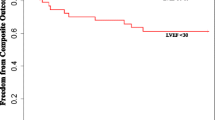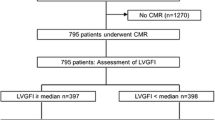Abstract
In patients with ST-segment elevation myocardial infarction (STEMI), it is unclear if combined assessment of left ventricular end-diastolic pressure (LVEDP) and left ventricular ejection fraction (LVEF) improves prediction of major adverse cardiac events (MACE). We analyzed data from 266 STEMI patients who underwent successful percutaneous coronary intervention and subsequent left ventriculography (LVG). Patients were divided into 4 groups, as follows: Group 1, LVEDP < 21 mmHg and LVEF ≥ 55%; Group 2, LVEDP < 21 mmHg and LVEF < 55%; Group 3, LVEDP ≥ 21 mmHg and LVEF ≥ 55%; and Group 4, LVEDP ≥ 21 mmHg and LVEF < 55%. Multivariate Cox proportional hazards analysis was used to determine if LVEDP and LVEF were associated with MACE (including cardiac death, non-fatal myocardial infarction, and heart failure requiring hospitalization). Change in LV parameters was assessed in the subset of 183 patients who underwent serial LVG (mean interval 6.3 ± 1.6 months). During a mean follow-up of 43 ± 31 months, 29 patients (10.9%) had a MACE. As compared to Group 1, MACE risk was significantly higher in Group 3 [hazard ratio (HR) 3.26; 95% confidence interval (CI) 1.05–10.0] and Group 4 (HR 3.99; 95% CI 1.44–11.0), but not in Group 2 (HR 0.46, 95% CI 0.54–3.96). In sub-analyses, LV end-systolic volume index after PCI was significantly higher in Group 4 than in the other groups and remained higher during follow-up. Combined LVEDP/LVEF assessment was useful in predicting MACE after successful PCI for STEMI patients and could facilitate risk stratification, as it predicts LV remodeling.

Similar content being viewed by others
References
Planer D, Mehran R, Witzenbichler B, Guagliumi G, Peruga JZ, Brodie BR, Dudek D, Mockel M, Reyes SL, Stone GW (2011) Prognostic utility of left ventricular end-diastolic pressure in patients with ST-segment elevation myocardial infarction undergoing primary percutaneous coronary intervention. Am J Cardiol 108(8):1068–1074
Ponikowski P, Voors AA, Anker SD, Bueno H, Cleland JG, Coats AJ, Falk V, Gonzalez-Juanatey JR, Harjola VP, Jankowska EA, Jessup M, Linde C, Nihoyannopoulos P, Parissis JT, Pieske B, Riley JP, Rosano GM, Ruilope LM, Ruschitzka F, Rutten FH, van der Meer P (2016) 2016 ESC guidelines for the diagnosis and treatment of acute and chronic heart failure. Rev Esp Card (Engl Ed) 69(12):1167
O’Gara PT, Kushner FG, Ascheim DD, Casey DE Jr, Chung MK, de Lemos JA, Ettinger SM, Fang JC, Fesmire FM, Franklin BA, Granger CB, Krumholz HM, Linderbaum JA, Morrow DA, Newby LK, Ornato JP, Ou N, Radford MJ, Tamis-Holland JE, Tommaso CL, Tracy CM, Woo YJ, Zhao DX, Anderson JL, Jacobs AK, Halperin JL, Albert NM, Brindis RG, Creager MA, DeMets D, Guyton RA, Hochman JS, Kovacs RJ, Kushner FG, Ohman EM, Stevenson WG, Yancy CW (2013) 2013 ACCF/AHA guideline for the management of ST-elevation myocardial infarction: a report of the American College of Cardiology Foundation/American Heart Association Task Force on Practice Guidelines. J Am Coll Cardiol 61(4):e78–140
Di Bella G, Pizzino F, Aquaro GD, Piaggi P, Venuti G, Carerj S, Pingitore A (2017) High-risk patients mild-moderate left ventricular dysfunction after a previous myocardial infarction. A long-term prognostic data by cardiac magnetic resonance. Int J Cardiol 245:13–19
Levine GN, Bates ER, Blankenship JC, Bailey SR, Bittl JA, Cercek B, Chambers CE, Ellis SG, Guyton RA, Hollenberg SM, Khot UN, Lange RA, Mauri L, Mehran R, Moussa ID, Mukherjee D, Ting HH, O’Gara PT, Kushner FG, Ascheim DD, Brindis RG, Casey DE Jr, Chung MK, de Lemos JA, Diercks DB, Fang JC, Franklin BA, Granger CB, Krumholz HM, Linderbaum JA, Morrow DA, Newby LK, Ornato JP, Ou N, Radford MJ, Tamis-Holland JE, Tommaso CL, Tracy CM, Woo YJ, Zhao DX (2016) 2015 ACC/AHA/SCAI focused update on primary percutaneous coronary intervention for patients with ST-elevation myocardial infarction: an update of the 2011 ACCF/AHA/SCAI guideline for percutaneous coronary intervention and the 2013 ACCF/AHA guideline for the management of ST-elevation myocardial infarction: a report of the American College of Cardiology/American Heart Association Task Force on Clinical Practice Guidelines and the Society for Cardiovascular Angiography and Interventions. Circulation 133(11):1135–1147
Sandler H, Dodge HT (1968) The use of single plane angiocardiograms for the calculation of left ventricular volume in man. Am Heart J 75(3):325–334
Bagai A, Armstrong PW, Stebbins A, Mahaffey KW, Hochman JS, Weaver WD, Patel MR, Granger CB, Lopes RD (2013) Prognostic implications of left ventricular end-diastolic pressure during primary percutaneous coronary intervention for ST-segment elevation myocardial infarction: findings from the Assessment of Pexelizumab in Acute Myocardial Infarction study. Am Heart J 166(5):913–919
Park SM, Ahn CM, Hong SJ, Kim YH, Park JH, Shim WJ, Lim DS (2015) Acute changes of left ventricular hemodynamics and function during percutaneous coronary intervention in patients with unprotected left main coronary artery disease. Heart Vessels 30(4):432–440
Diamond G, Forrester JS (1972) Effect of coronary artery disease and acute myocardial infarction on left ventricular compliance in man. Circulation 45(1):11–19
Porteous MK, Ky B, Kirkpatrick JN, Shinohara R, Diamond JM, Shah RJ, Lee JC, Christie JD, Kawut SM (2016) Diastolic dysfunction increases the risk of primary graft dysfunction after lung transplant. Am J Respir Crit Care Med 193(12):1392–1400
Kirtane AJ, Bui A, Murphy SA, Karmpaliotis D, Kosmidou I, Boundy K, Rahman A, Pinto DS, Aroesty JM, Giugliano RP, Cannon CP, Antman EM, Gibson CM (2004) Association of epicardial and tissue-level reperfusion with left ventricular end-diastolic pressures in ST-elevation myocardial infarction. J Thromb Thrombolysis 17(3):177–184
Van Herck PL, Carlier SG, Claeys MJ, Haine SE, Gorissen P, Miljoen H, Bosmans JM, Vrints CJ (2007) Coronary microvascular dysfunction after myocardial infarction: increased coronary zero flow pressure both in the infarcted and in the remote myocardium is mainly related to left ventricular filling pressure. Heart 93(10):1231–1237
Daneault B, Genereux P, Kirtane AJ, Witzenbichler B, Guagliumi G, Paradis JM, Fahy MP, Mehran R, Stone GW (2013) Comparison of three-year outcomes after primary percutaneous coronary intervention in patients with left ventricular ejection fraction < 40% versus >/= 40% (from the HORIZONS-AMI trial). Am J Cardiol 111(1):12–20
Halkin A, Singh M, Nikolsky E, Grines CL, Tcheng JE, Garcia E, Cox DA, Turco M, Stuckey TD, Na Y, Lansky AJ, Gersh BJ, O’Neill WW, Mehran R, Stone GW (2005) Prediction of mortality after primary percutaneous coronary intervention for acute myocardial infarction: the CADILLAC risk score. J Am Coll Cardiol 45(9):1397–1405
Ergelen M, Gorgulu S, Uyarel H, Norgaz T, Ayhan E, Akkaya E, Soylu O, Ugur M, Tv Tezel (2010) Prediction of cardiovascular mortality in patients with ST-elevation myocardial infarction after primary percutaneous coronary intervention. Coron Artery Dis 21(4):207–211
Dutcher JR, Kahn J, Grines C, Franklin B (2007) Comparison of left ventricular ejection fraction and exercise capacity as predictors of two- and five-year mortality following acute myocardial infarction. Am J Cardiol 99(4):436–441
Hendriks T, Hartman MH, Vlaar PJ, Prakken NH, van der Ende YM, Lexis CP, van Veldhuisen DJ, van der Horst IC, Lipsic E, Nijveldt R, van der Harst P (2017) Predictors of left ventricular remodeling after ST-elevation myocardial infarction. Int J Cardiovasc Imaging. https://doi.org/10.1007/s10554-017-1131-1
Nguyen TL, Phan J, Hogan J, Hee L, Moses D, Otton J, Premawardhana U, Rajaratnam R, Juergens CP, Dimitri H, French JK, Richards D, Thomas L (2016) Adverse diastolic remodeling after reperfused ST-elevation myocardial infarction: an important prognostic indicator. Am Heart J 180:117–127
Otasevic P, Neskovic AN, Popovic Z, Vlahovic A, Bojic D, Bojic M, Popovic AD (2001) Short early filling deceleration time on day 1 after acute myocardial infarction is associated with short and long term left ventricular remodelling. Heart 85(5):527–532
Wu E, Ortiz JT, Tejedor P, Lee DC, Bucciarelli-Ducci C, Kansal P, Carr JC, Holly TA, Lloyd-Jones D, Klocke FJ, Bonow RO (2008) Infarct size by contrast enhanced cardiac magnetic resonance is a stronger predictor of outcomes than left ventricular ejection fraction or end-systolic volume index: prospective cohort study. Heart 94(6):730–736
Yancy CW, Jessup M, Bozkurt B, Butler J, Jr Casey D E, Colvin MM, Drazner MH, Filippatos GS, Fonarow GC, Givertz MM, Hollenberg SM, Lindenfeld J, Masoudi FA, McBridi PE, Peterson PN, Stevenson LW, Westlake C (2017) 2017 ACC/AHA/HFSA focus update of the 2013 ACC/AHA guideline for the management of heart failure; a report of the American College of Cardiology/American Heart Association Task Force on Clinical Practice Guideline and the Heart Failure Society of America. J Am Coll Cardiol 70(6):776–803
Acknowledgements
This research was supported in part by Grants-in-Aid (15K09103 and 16K01433 to T.I.) for Scientific Research from the Ministry of Education, Culture, Sports, Science and Technology of Japan.
Author information
Authors and Affiliations
Corresponding author
Ethics declarations
Conflict of interest
TI received grant support from Bristol-Myers Squibb and Daiichi Sankyo and lecture fees from Bayer Healthcare, Bristol-Myers Squibb, Pfizer, Daiichi Sankyo, Tanabe-Mitsubishi, and Ono Pharmaceutical. The other authors report no conflicts of interest.
Additional information
IRB approval number: M16259.
Rights and permissions
About this article
Cite this article
Saito, D., Nakanishi, R., Watanabe, I. et al. Combined assessment of left ventricular end-diastolic pressure and ejection fraction by left ventriculography predicts long-term outcomes of patients with ST-segment elevation myocardial infarction. Heart Vessels 33, 453–461 (2018). https://doi.org/10.1007/s00380-017-1080-6
Received:
Accepted:
Published:
Issue Date:
DOI: https://doi.org/10.1007/s00380-017-1080-6




